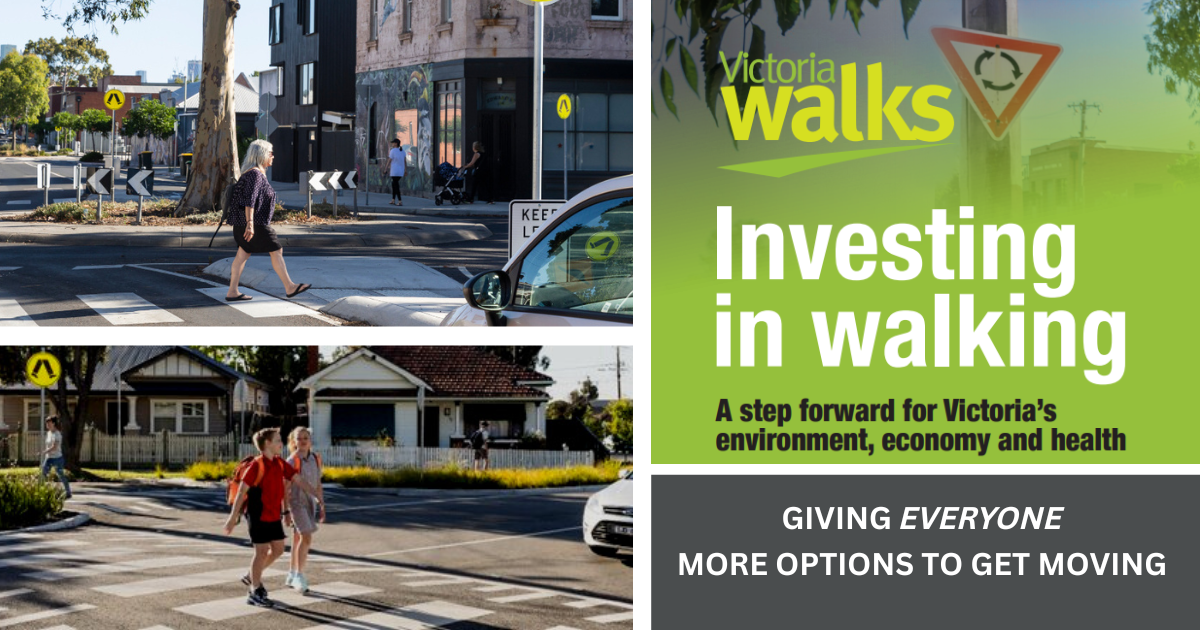Position statements
Investment and Victorian election 2022

In the approach to the 2022 Victorian State Election, Victoria Walks is asking parties to commit to a range of policy changes and investment to demonstrably improve state-wide walking outcomes.
The Victorian Walking Survey showed strong public support for action to provide better walking conditions. Three-quarters of people said the government should make it safer and easier to walk to local shops.
To demonstrate the potential for investment in walking, Victoria Walks invited Victorian councils to put forward projects requiring funding. Just over half responded, along with two water authorities, to provide 522 walking projects worth $469 million.
Victoria Walks is calling for a total investment of $942m over four years to give all councils and public agencies the capacity to deliver the safer streets, recreation opportunities and tourism trails that the community want.
To find out more, including case studies and details of suggested projects, check out the proposals:
Safe speed (2021)

After reviewing the evidence and consulting with road safety experts Victoria Walks has issued a comprehensive position statement on speed limits.
Key recommendations for the state government include:
- Review speed limits on arterial roads currently set at 60 km/h or more
- Reducing the default urban speed limit for local roads from 50 to 40 km/h
- Give councils the option of applying 30 km/h speed limits in areas of high pedestrian activity
- Rethink school zones to allow reduced speed across the school neighbourhood, not limited to outside the school gate
- Simplify state government approval processes for reduced speed limits and invest in street changes to support lower speeds.
While reduced speed limits might attract some noisy opposition, a recent survey found 64% of Australians and 66% of Victorians support lower speed limits in neighbourhood streets.
Read our news story on release of the position statement
Check out the full position statement with evidence in support of lower speeds
You can watch lead author Jo Eady present the findings to the Metropolitan Transport Forum in this video
Footpath cycling (2018)
Some cycling groups are campaigning to be able to ride on footpaths (in some states they already can).
Victoria Walks commissioned transport consultants MRCagney to review the evidence on footpath cycling. Find out more here.
Previously, the main cycling groups campaigned only for teenagers up to 16 years old to ride on footpaths (a significant jump from the current age limit of up to 12 years). Victoria Walks released a position statement - Footpaths are for Feet - that highlighted the reasons why a change in road laws would be a mistake. This position is supported by Vision Australia, National Disability Services and the Council on the Ageing (COTA).
Our footpaths are not built for cycling, but they are critical for many seniors, children, families, those on mobility scooters and the disabled to get around. More bikes on footpaths will put many off walking.
Shared paths (2015)

Cycling ridership is growing very quickly and shared walking and cycling paths are the most common form of off-road cycling facility in Australia.
Victoria Walks has reservations regarding shared paths and how they impact walking, particularly by more vulnerable walkers. Generally, slow moving recreational cyclists may be able to share paths with walkers, but commuter and sports cyclists typically travel at higher speed.
Victoria Walks have developed a comprehensive research paper, Shared paths – the issues, based on a literature review and stakeholder consultation with subject experts, VicRoads and 18 local councils. This provides the basis for our short position statement Shared paths – finding solutions.
The research paper and position statement set out options and recommendations for infrastructure that work for both walkers and cyclists.
